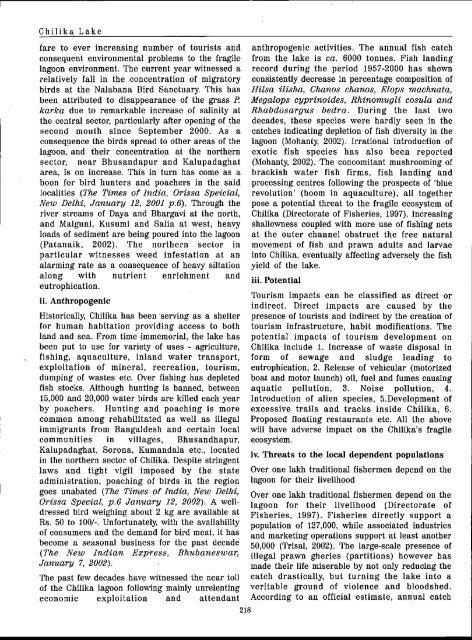06-bioresourcesstatu.. - M. S. Swaminathan Research Foundation
06-bioresourcesstatu.. - M. S. Swaminathan Research Foundation
06-bioresourcesstatu.. - M. S. Swaminathan Research Foundation
You also want an ePaper? Increase the reach of your titles
YUMPU automatically turns print PDFs into web optimized ePapers that Google loves.
Chilika Lake<br />
fare to ever increasing number of tourists and<br />
consequent environmental problems to the fragile<br />
lagoon environment. The current year witnessed a<br />
relatively fall in the concentration of migratory<br />
birds at the Nalabana Bird Sanctuary. This has<br />
been attributed to disappearance of the grass P.<br />
karka due to remarkable increase of salinity at<br />
the central sector, particularly after opening of the<br />
second mouth since September 2000. As a<br />
consequence the birds spread to other areas of the<br />
lagoon, and their concentration at the northern<br />
sector, near Bhusandapur and Kalupadaghat<br />
area, is on increase. This in turn has come as a<br />
boon for bird hunters and poachers in the said<br />
localities (The Times of India, Orissa Speicial,<br />
New Delhi, January 12, 2001 p.6). Through the<br />
river streams of Daya and Bhargavi at the north,<br />
and Malguni, Kusumi and Salia at west, heavy<br />
loads of sediment are being poured into the lagoon<br />
(Patanaik, 2002). The northern sector in<br />
particular witnesses weed infestation at an<br />
alarming rate as a consequence of heavy siltation<br />
along with nutrient enrichment and<br />
eutrophication.<br />
ii. Anthropogenic<br />
Historically; Chilika has been serving as a shelter<br />
for human habitation providing access to both<br />
land and sea. From time Immemorial, the lake has<br />
been put to use for variety of uses - agriculture,<br />
fishing; aquaculture, inland water transport,<br />
exploitation of mineral, recreation, tourism,<br />
dumping of wastes etc. Over fishing has depleted<br />
fish stocks. Although hunting is banned, between<br />
15,000and 20,000 water birds are kIlled each year<br />
by poachers. Hunting and poaching is more<br />
common among rehabilitated as well as illegal<br />
immigrants from Bangaldesh and certain local<br />
communities in villages, Bhusandhapur,<br />
Kalupadaghat, Sorona, Kumandala etc., located<br />
in the northern sector of Chilikli. Despite stringent<br />
laws and tight vigil imposed by the state<br />
administration, poaching of birds in the region<br />
goes unabated (The Times of India, New Delhi,<br />
Orissa Special, p.6 January 12, 2002). A welldressed<br />
bird weighing about 2 kg are available at<br />
Rs. 50 to 100/-. Unfortunately, with the availability<br />
of consumers and the demand for bird meat, it has<br />
become a seasonal business for the past decade<br />
(The New Indian Express, Bhubaneswar,<br />
January 7, 2002).<br />
anthropogenic activities. The annual fish catch<br />
from the lake is ca. 6000 tonnes. Fish landing<br />
record during the period 1957-2000 has shown<br />
consistently decrease in percentage composition of<br />
Hilsa ilisha, Chanos chanos, Elops machnata,<br />
Megalops cyprinoides, Rhinomugli cosula and<br />
Rhabdosargus bedra. During the last two<br />
decades, these species were hardly seen in the<br />
catches indicating depletion of fish diversity in the<br />
lagoon (Mohanty, 2002). Irrational introduction of<br />
exotic fish species has also been reported<br />
(Mohanty,2002). The concomitant mushrooming of<br />
brackish water fish firms, fish landing and<br />
processing centres following the prospects of 'blue<br />
revolution' (boom in aquaculture), all together<br />
pose a potential threat to the fragile ecosystem of<br />
Chilika (Directorate of Fisheries, 1997). Increasing<br />
shallowness coupled with more use of fishing nets<br />
at the outer channel obstruct the free natural<br />
movement of fish and prawn adults and larvae<br />
into Chilika, eventually affecting adversely the fish<br />
yIeld of the lake.<br />
iii. Potential<br />
Tourism impacts can be classified as direct or<br />
indirect. Direct impacts are caused by the<br />
presence of tourists and indirect by the creation of<br />
tourism infrastructure, habit modifications. The<br />
potential impacts of tourism development on<br />
Chilika include 1. Increase of waste disposal in<br />
form of sewage and sludge leading to<br />
eutrophication, 2. Release of vehicular (motorized<br />
boat and motor launch) oil, fuel and fumes causing<br />
aquatic pollution, 3. Noise pollution, 4.<br />
Introduction of alien species, 5.Development of<br />
excessive trails and tracks inside Chilika, 6.<br />
Proposed floating restaurants etc. All the above<br />
will have adverse impact on the Chilika's fragile<br />
ecosystem.<br />
iv. Threats to the local dependent populations<br />
Over one lakh traditional fishermen depend on the<br />
lagoon for their livelihood<br />
Over one lakh traditional fishermen depend on the<br />
lagoon for their livelihood (Directorate of<br />
Fisheries, 1997). Fisheries directly support a<br />
population of 127,000,while associated industries<br />
and marketing operations support at least another<br />
50,000 (Trisal, 2002). The large-scale presence of<br />
illegal prawn gheries (partitions) however has<br />
made their life miserable by not only reducing the<br />
The past few decades have witnessed the near toll catch drastically, but turning the lake into a<br />
of the Chilika lagoon following mainly unrelenting veritable ground of violence and bloodshed.<br />
economic exploitation and attendant According to an official estimate, annual catch<br />
218










